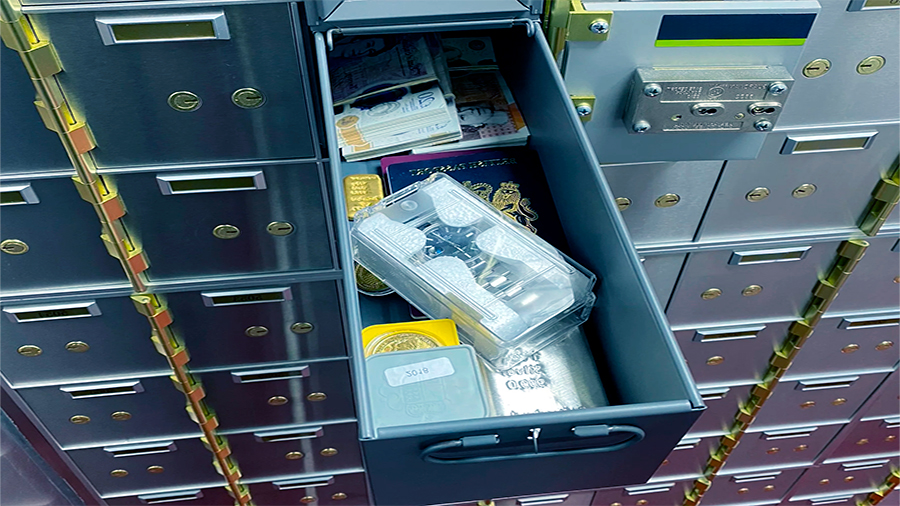Safe Storage Solutions for Precious Metals on Credit: Banks, Vaults, Home Options, and Risk Reduction

Safe Storage Of Precious Metals Purchased On Credit
Buying gold or silver with borrowed funds introduces both opportunity and responsibility. You gain access to a stable store of value, yet you also carry the obligation of repayment. That dual reality makes storage a critical decision. If something happens to your metals, the debt remains. Safe storage is not just about security; it is about preserving collateral for your loan. By examining home storage, bank deposit boxes, private vaults, and diversified strategies, we can see how each option works in practice and how borrowers can minimize risks while meeting repayment schedules.
Why Storage Matters When Precious Metals Are Bought With Loans
Precious metals purchased on credit differ from those bought with cash. Debt repayments are fixed, regardless of market price or personal circumstances. This means any loss—whether theft, damage, or fraud—creates a double problem. You lose the asset and still owe the lender. Unlike stocks or bonds, metals require physical custody, making them uniquely vulnerable. For this reason, choosing the right storage location becomes a fundamental part of your investment strategy. Credit obligations magnify the importance of safeguarding your holdings because any compromise in security translates directly into financial stress.
Home Storage: Convenience And Exposure
Keeping metals at home is the simplest option. You retain full control, immediate access, and avoid third-party fees. A fireproof safe combined with a modern alarm system can add layers of security. However, when borrowed money is involved, risks rise sharply. A burglary, house fire, or accidental damage could erase your collateral overnight. Consider an investor who used a $10,000 personal loan to buy silver bars and stored them in a household safe. After a burglary, the bars were gone but the debt remained. For small purchases, home storage may be manageable, but with loan-based acquisitions, the downside is too severe to ignore.
| Home Storage Method | Advantages | Disadvantages |
|---|---|---|
| Basic Safe | Cheap, immediate access | Vulnerable to burglary and fire |
| Hidden Compartment | Low cost, discreet | No insurance coverage, not disaster-proof |
| Safe With Alarm | Better protection than basic methods | Still weaker than professional vaults |
Bank Safe Deposit Boxes: Secure But Limited
Safe deposit boxes at banks are a traditional solution. They provide strong physical protection at low annual cost, often between $100 and $300 depending on size. For metals purchased with credit, banks offer a low-risk way to preserve collateral. Yet, there are limits. Boxes can only be accessed during banking hours, which reduces flexibility. In times of crisis, access may be restricted. Insurance coverage is often limited or optional, requiring additional policies. Despite these challenges, many borrowers find bank storage practical, particularly for moderate amounts of gold or silver where risk tolerance is low and cost sensitivity is high.
| Box Size | Annual Cost | Best Use |
|---|---|---|
| Small | $50 – $150 | Gold coins or small jewelry under $5,000 |
| Medium | $150 – $300 | Silver coins and small bars up to $20,000 |
| Large | $300 – $600 | Larger bars and mixed metals above $30,000 |
Private Vaults: Maximum Protection For Borrowed Investments
Private vaults provide the highest security and most comprehensive insurance. These facilities feature biometric access, 24/7 surveillance, and armored protection. Unlike banks, some vaults allow trading directly from storage, enabling fast sales without physically moving the assets. This is especially important for those with loans, as repayment deadlines can be strict and market opportunities fleeting. Costs are higher—typically $500 to $1,500 annually—but for significant credit-backed holdings, this expense is justified. Imagine a borrower who purchased $25,000 in gold using a loan. A private vault not only protected the bars but also enabled quick liquidation when prices spiked, covering repayment and securing profit.
Key Features Of Private Vault Storage
- Full insurance covering the entire market value of metals.
- 24/7 monitored facilities with biometric entry.
- Trading integration with digital platforms.
- Custom storage solutions for coins, bars, and bullion.
Diversified Storage: Reducing Single-Point Failure
Diversification is not only for investment portfolios but also for storage strategies. By splitting metals across different locations, you lower exposure to theft, disaster, or political restrictions. For example, half of your metals might be kept in a domestic bank and half in an overseas private vault. This way, a burglary or a local banking restriction cannot wipe out your entire holding. For credit-based purchases, diversification is especially valuable since losing all collateral would leave only debt behind. The tradeoff is higher costs and logistical complexity. For large loans, however, these drawbacks are outweighed by the reduction in catastrophic risk.
| Storage Strategy | Advantages | Challenges |
|---|---|---|
| Single Location | Simple, low cost | Higher exposure if compromised |
| Multiple Domestic Sites | Reduces local theft/fire risk | Double fees, more logistics |
| Domestic + International | Protection from national instability | Access delays, higher regulation |
Insurance: Essential For Credit-Funded Metals
Insurance is the final layer of protection, and for credit-based purchases, it is not optional. Even the best vaults cannot eliminate all risks. Fires, floods, or systemic failures may still cause losses. Insurance guarantees replacement at full market value, ensuring your repayment schedule can still be met. For instance, a $10,000 gold purchase funded with a loan can be insured for as little as $200 annually. Without this protection, a single event could leave you with both no asset and an ongoing debt. Combining insurance with secure storage creates a strong shield against unexpected losses.
Real-World Examples Of Storage Strategies
To understand how storage works in practice, consider these scenarios:
- A student investor used a $2,500 loan to buy gold coins. They kept the coins in a bank deposit box at $120 annually. The low cost relative to loan size ensured safety while repayments continued without added stress.
- A business borrowed $20,000 to hedge with silver. They split holdings between a domestic private vault and an overseas vault, paying higher fees but ensuring no single-point failure. When political instability affected local banks, the overseas vault preserved half their collateral.
- A family bought $15,000 in gold using credit. They stored part at home, part at the bank, and part in a private vault. The home portion gave immediate access, while the rest remained protected. Although fees were higher, this approach balanced accessibility with safety.
The Conclusion
Precious metals purchased with borrowed funds require more careful storage decisions than those bought with savings. Home safes offer control but expose assets to theft and disaster. Bank deposit boxes balance cost and safety, while private vaults deliver unmatched security, insurance, and liquidity at higher expense. Diversified storage spreads risks but increases complexity. Insurance remains indispensable, covering risks no vault can fully prevent. For anyone managing repayment obligations, storage is not an afterthought—it is the foundation of protecting both metals and the credit used to acquire them. The correct choice depends on your loan size, budget, and risk tolerance, but the principle remains: when debt is involved, storage must be as secure as possible.



